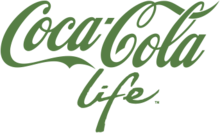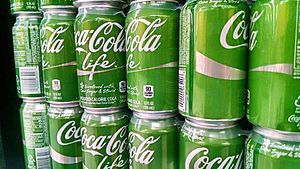Coca-Cola Life facts for kids
 |
|

Coca-Cola Life cans on a public grocery store shelf.
|
|
| Type | Cola |
|---|---|
| Manufacturer | The Coca-Cola Company |
| Distributor | The Coca-Cola Company |
| Country of origin | Argentina Chile |
| Introduced | 2015 |
| Discontinued | 2019 (Europe and Canada only) 2020 (everywhere else) |
| Flavor | Cola |
| Related products | Coca-Cola Diet Coke Pepsi True |
Coca-Cola Life was a special version of Coca-Cola that had fewer calories. It was made using two types of sweeteners: stevia and regular sugar. This drink was first launched in Argentina and Chile in 2013 after five years of research.
The recipe for Coca-Cola Life was a bit different depending on the country. In some places, the original version was replaced with a zero-calorie drink that only used stevia. Coca-Cola Life was eventually stopped in 2020. This happened because The Coca-Cola Company decided to stop making brands that were not selling very well.
Contents
What was in Coca-Cola Life?
Coca-Cola Life was the first Coke product to use stevia leaf extract. Stevia is a natural sweetener that comes from a plant. However, it wasn't the first drink from The Coca-Cola Company to use stevia. More than 45 other products from the company, like Vitamin Water and Seagram's Ginger Ale, also used stevia.
Coca-Cola Life still had sugar, but it used less sugar than regular Coca-Cola. For example, a small serving (about 8 ounces or 237 ml) had around 60 calories. This was about one-third less sugar than traditional Coca-Cola.
How was it Packaged?
Coca-Cola Life came in different containers. You could find it in glass bottles, plastic bottles, and aluminum cans. The logo on the packaging had a small green leaf.
In 2018, a red circle was added behind the name. This was done to make it look more like other Coca-Cola products. The plastic bottles were special because they were 30 percent plant-based. This meant they used less fossil-fuel plastic and were still fully recyclable.
Where was it Sold?
Coca-Cola Life first came out in Argentina in June 2013. It then launched in Chile in November of the same year. After that, it was introduced in many other countries, including Sweden and the United Kingdom in 2014.
The company hoped Coca-Cola Life would be popular alongside Diet Coke and Coca-Cola Zero. However, it wasn't very popular with customers in Argentina and Chile. Because sales were low, Coca-Cola Life was stopped in the UK in June 2017. It was also removed from many other markets over time.
Coca-Cola Life was available in many countries, such as:
- Argentina
- Australia
- Canada
- Chile
- France
- Germany
- Japan
- New Zealand
- Russia
- South Africa
- United Kingdom
- United States
Coca-Cola Life in the United States
Coca-Cola Life was first sold in a few places in the United States in the summer of 2014. It became available across the whole country on November 4, 2014. This was the first new Coca-Cola product launched in the U.S. since 2006.
The U.S. version had 90 calories and 24 grams of sugar per 12-ounce can. Before it was widely released, early studies showed that people liked the drink. The company even held 4,000 events where people could try it for free.
Coca-Cola Life in the United Kingdom
Coca-Cola Life was offered to customers in the United Kingdom starting in September 2014. This was the first new Coca-Cola product there in eight years. In 2016, the recipe was changed to have even less sugar, about 45% less than regular Coke.
However, sales went down, and sales of Coca-Cola Zero Sugar went up. So, Coca-Cola Life was stopped in the UK in June 2017. To help promote the drink, the company even had famous model Rosie Huntington-Whiteley at a launch party in London.
Some taste tests were done in the UK. Many people could tell the difference between Coca-Cola Life and classic Coca-Cola. Interestingly, many people said they actually preferred the taste of Coca-Cola Life.
Coca-Cola Life in Argentina
In Argentina, the launch of Coca-Cola Life focused on its special bottle. The drink came in Coca-Cola's "PlantBottle." This bottle was made from recyclable petroleum-based material and about 30 percent plant-based material.
Coca-Cola also released a funny TV ad in Argentina called "Parents." This ad showed the challenges of being new parents. The marketing in Argentina, like in the UK, focused on promoting healthy lifestyles.
Why some people didn't like it
Some people thought Coca-Cola Life was just a marketing trick. They felt it was a way for Coca-Cola to make its older image seem more modern and "green." They called it "greenwashing," which means making something seem more environmentally friendly than it really is.
See also
 In Spanish: Coca-Cola Life para niños
In Spanish: Coca-Cola Life para niños



